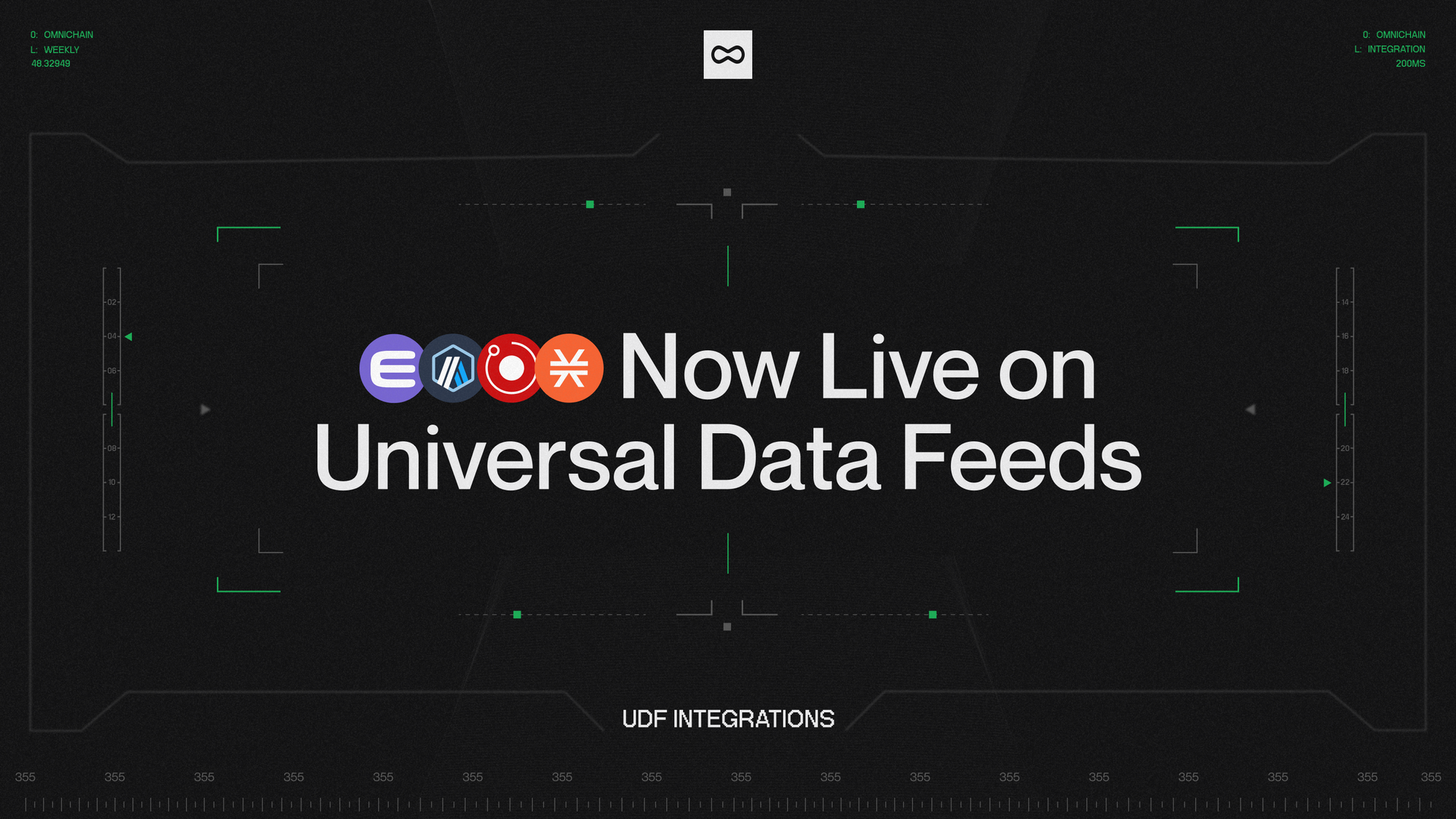Rendering the Future: UDF Meets Enjin, Arbitrum, Render & STX

Entangle continues to expand its omnichain vision with the latest integrations of Enjin (ENJ), Arbitrum (ARB), Render (RNDR), and Stacks (STX) into Universal Data Feeds (UDF). These integrations provide near-instant cross-chain data access to some of the most advanced blockchain ecosystems, unlocking their full potential.
Enjin x UDF
Enjin drives NFT innovation in gaming and virtual worlds. Initially launched on Ethereum, Enjin has evolved to art, sports, or even real-world tokenization. Since Enjin works on top of Ethereum, the ENJ token doesn't serve the governance function that some native tokens do.
With UDF integration, Enjin enhances the utility of its digital assets across multiple blockchain platforms.
Why Enjin?
Since its launch, Enjin has become more than just a gaming-centric platform. It has use cases in NFT in the real world. However, as an ecosystem based on Ethereum, Enjin faces similar scalability challenges, high gas fees, and lack of real-time data synchronization for dynamic NFTs.
The integration of UDF with Enjin marks a significant leap forward in addressing these issues and enhancing the utility of digital assets.
Key Benefits of UDF for Enjin
- Cross-Chain NFT Interoperability. UDF facilitates data flow across different networks. UDF provides real-time synchronization of NFT ownership, pricing, and metadata across multiple platforms.
- Enhanced Smart Contract Communication. UDF offers a standardized data model that simplifies contract interactions.
- Data Verification and Security Challenges. UDF enhances data authenticity and integrity by sourcing information from multiple authenticated sources. This approach minimizes reliance on centralized oracles and enhances trust in Enjin’s virtual economies.
Arbitrum x UDF
Arbitrum, the leading Layer 2 scaling solution is now integrated with UDF. The network optimizes data flows through the optimistic rollup architecture, expanding possibilities for developers and dApps.
Why Arbitrum?
Arbitrum solves Ethereum’s congestion and high gas fee problems by offering off-chain transaction processing with on-chain security. However, real-time access to external blockchain data hinders DeFi innovation and cross-chain execution.
Key Benefits of UDF for Arbitrum
- Frictionless Data Synchronization: Real-time updates flow directly to rollup-based apps, eliminating off-chain data latency.
- Optimized Gas Costs: Reliable off-chain data verification reduces smart contract execution costs while maintaining security.
- Enhanced Composability for DeFi Apps: Cross-chain liquidity providers and lending protocols operate with faster settlement times and reduced risk.
How This Benefits Developers and Users
- Lower Gas Fees, Higher Efficiency: Real-time market data improves trade execution while reducing computational costs and gas fees.
- Multi-Chain Strategy Optimization: DeFi protocols leverage accurate, instant data for advanced lending and arbitrage strategies.
- Institutional Integration: Financial apps access standardized, high-fidelity market data through UDF.
Render x UDF
Render Network, a decentralized GPU rendering platform, integrates Universal Data Feeds (UDF). The integration optimizes data flows and economic models for both creators and GPU node operators.
Why Render?
Render creates a decentralized GPU platform, connecting providers with creators of 3D visuals, AI content, AR/VR apps, and metaverse environments. While the Render overcomes traditional cloud rental costs, it faces specific challenges in pricing transparency and workload distribution.
Key Benefits of UDF for Render
- Real-Time Compute Task Distribution: UDF makes it possible for developers operating in the Render ecosystem to access verifiable real-time data that enables compute distribution.
- Enhanced Security and Validation. By leveraging UDF's trustless data infrastructure, Render can verify compute tasks and payment on-chain.
UDF's integration empowers Render Network to optimize resource allocation and synchronize computational tasks, setting a new standard for decentralized GPU computing.
STX x UDF
Stacks (STX) advances Bitcoin-based smart contracts and DeFi through UDF integration. Developers on STX harness UDF's verified data feeds to power next-generation financial products. This integration enables precise, trustless data delivery for Defi protocols, derivatives markets, and automated trading strategies.
Why Stacks (STX)?
Stacks extends Bitcoin’s utility by introducing programmable smart contracts via the Clarity language, but it faces challenges in real-time data access and transaction speed. As Bitcoin itself lacks native DeFi capabilities, Stacks acts as an extension layer. However, without trustless and verifiable off-chain data, the potential of ecosystem apps remains limited.
Through integration with UDF, Stacks overcomes these barriers, allowing secure access to external price feeds and verifiable financial data without compromising Bitcoin’s trust model.
Key Benefits of UDF for STX
- Enhanced On-Chain Data: UDF supplies real-time price feeds and financial data without reliance on centralized oracles.
- Advanced Smart Contract Capabilities: Stacks' microblocks improve transaction speeds, but with UDF, smart contract execution is further optimized by reducing latency in data retrieval and processing.
- Expanded Bitcoin Utility: UDF allows BTC-backed assets and Stacks-based tokens to interact with liquidity pools on other chains, expanding DeFi accessibility beyond Stacks ecosystem.
How This Benefits Developers and Users
- Developers Gain Real-Time Data Integration: Smart contracts utilize external financial metrics, market trends, and security analytics to drive dynamic dApp functionality.
- Users Experience More Efficient Transactions: Instant data retrieval powers responsive financial products with real-time pricing and execution.
- Enhanced Security and Compliance: On-chain verification of financial events enables transparent, auditable transactions that meet institutional standards.
- More Reliable Bitcoin-Powered DeFi: Accurate BTC valuation and risk metrics protect against pricing errors and unstable trading mechanisms.
Real-Time Data, Real-World Impact
As blockchain ecosystems grow increasingly complex and interconnected, the ability to access reliable, real-time data across networks has become a necessity rather than a luxury. With the latest UDF integrations into Enjin, Arbitrum, Render, and Stacks, Entangle continues to push the boundaries of what’s possible in DeFi and complex computational rendering.
Each network now benefits from instant data availability and an expanded range of use cases.
As we look ahead, the demand for real-time, trustless, and cross-chain data solutions will only continue to grow, and UDF remains at the forefront of this transformation.
Stay tuned—because the next wave of blockchain evolution is powered by data.
Learn more about the ecosystems and UDF:
Visit our documentation for integration guides